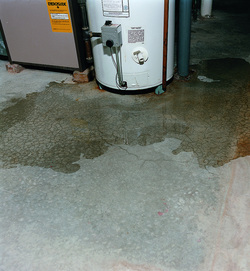I am using an excerpt for this week’s blog directly from an article in the Las Vegas Review Journal on Sunday, May 11th because it so accurately shows an example of a plumbing nightmare that can be cheaply avoided.
The article is titled: “Mold Gives Tenants Tricky Challenge”
“Just a few days before Thanksgiving, David opened the garage door of his rented home and was hit with a nasty surprise. His water heater had burst and flooded the house. He called his landlady. Next came water extraction and the pulling back of baseboards. Old mold lurked beneath the baseboards- not something that had developed in a day. According to David, it extended throughout the house. It had invaded the laundry area. It was ensconced in the kitchen wall.
The guy came in and said, I’m not equipped to do this kind of work. David recalled. “It was pretty bizarre.”
Two guys showed up in a pickup truck with no business license, David said. They simply replaced the drywall.
Mold presents special challenges for tenants, who often lack the money necessary to prosecute a claim against negligent landlords or insurance companies that try to avoid paying out what is covered under a renter’s insurance policy.
Losses can include personal injury caused by mold exposure; personal property damage and replacement, out of pocket moving expenses, security deposits on a new home, additional living expenses when someone is left homeless; and storage.”
This article also had a box in which expert tips were proffered. One tip was to check the water heater for visual discoloration. It says “If possible check on its age or whether it had leaked previously” There is no mention of a pan, however.
What? Leaked previously?
When the inner water heater tank leaks, the ballgame is over. A water heater consists of an inner steel tank that holds the water, a layer of fiberglass insulation and then the outer decorative liner. Water heaters always leak in such a way that the leaking water runs down between the inner tank and outer liner, then hopefully into a PAN!!!!
A $24 drain pan placed under the heater, even if it is only PVC piped to the garage floor would have eliminated all this horror and heartache. Ideally, the pan should be piped through the garage wall to the outside. According to code, garage floors are required to be graded down to the driveway in case gasoline spills on the floor. At least that is the reason for the code. If the heater is on an upper floor it must be piped to the outside somehow. An experienced plumber can make this happen.
I know what you’re thinking. Aren’t pans under water heaters code? The answer is no. You will not find a requirement for a drain pan in the current plumbing code. They did, however recently add a requirement that you must install a drip leg where the gas line enters the water heater control so condensate can have somewhere to go and can be taken apart and cleaned. This requirement is ferociously enforced by our plumbing inspectors, but they do not deem a drain pan necessary. In 35 years, I have never seen a water heater gas line plugged by condensation build up in the gas line. Never! It simply does not happen. Go figure. It makes no sense.
I service a 24 year old two story condo complex that has at least 60 first and second floor water heaters with no pans under any of them. Several have leaked and flooded out one or more of the units and cost many thousands of dollars and untold misery to all concerned. The condo board cannot force the owners to install pans because it is not in the code. I would not buy or rent any apartment, house or condo that did not have panned water heaters near my unit.
The cost of installing a pan under an existing water heater is $250-$300. The heater has to be drained before it can be moved, the pan has to be put in place and piped to the outside so WHEN it leaks, the water has somewhere to go other than into your home or someone else’s. A small price to pay for peace of mind.






